
| Wes Boyd's Spearfish Lake Tales Contemporary Mainstream Books and Serials Online |

Elves Chasm, Deer Creek, Backeddy Camp (Mile 137)

| Wes Boyd's Spearfish Lake Tales Contemporary Mainstream Books and Serials Online |

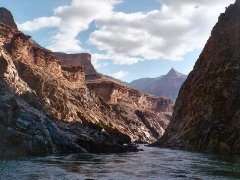 |
|
On the river below Bass Camp, our fifth day out. |
Up early once again -- one of the bad things about being close to the kitchen, and I was only a few feet away, is that the roar of the propane burners wakes you up early, but it's conducive to getting around. This camp and my spot proved to the be best yet, with the whisper of Shinumo Rapids a few hundred yards downstream. I got around in good order, got some coffee, and was packed by the time the crew called "Breakfast", which was French toast, strawberries and bacon -- very good, although I hit the bacon a little hard.
The day was promising for warmth, and there are few big rapids coming today, and then toward the end of the day, so I decided to stuff the rain gear in the day bag and just run in my regular clothes. As always, there's a bit of waiting around to get going, as some stragglers don't get around well in the morning, and the crew is still cleaning up from breakfast and loading the rafts -- most of the kitchen stuff has to be down in the gear boxes in places only they know, and bigger items, like tables, have specific spots as well -- some have to be gotten to during the day for lunch. Eventually, it's time to get started loading for real, and the call of "duffle line" goes up. Most of the passengers -- except for those up at the groover or still getting their acts together, form a line to pass up the gear.
Tent bags and night bags go in first. The tent bags are heavy, and there's always a little grunting and groaning when one of them comes along. The crew places these big bags, with a row along each sideboard, the rolls facing down to provide something of a fence for the rest of the bags, and something of a seat for people to sit on, although it isn't much of a seat. Once all these are packed, the night bags are called for, and they are packed in between the big bags, and wherever else they can be stashed. Once the night bags are aboard, the load it covered with a tarp, and tied down with straps.
Now, people can start getting aboard the raft. This is always confusing, as people are pulling on life jackets and raingear, and hooking the strap at the bottom of their day bags onto the tarp straps anywhere they can. People settle into place, and a couple of the crew head up and get the groover, heavier now than it was the night before. It's handed aboard, and tied down back in the boatmen's well. There are in fact several, one for each day except the first and the last; those have to do double duty.
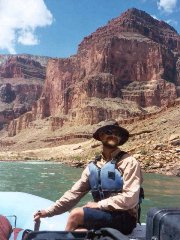 |
|
Joe at the helm in Middle Granite Gorge, our fifth day out. |
By this time, the boatmen, who by seniority don't usually deal with the rocket boxes, are warming up the outboards. They're relatively quiet, although the noise is noticeable. By this time, people are settling into place, and one of the crewmen runs up to untie the lines that have held the raft to shore, coiling up the rope and placing it on the "Beaver Board" at the front of the raft. Usually, the boatmen have to swing their motors to the side and push them hard to twist the boat from shore, breaking it loose from where it's sat all night, and sometimes one or more of the crewmen, and sometimes even one or two of the passengers, has to get out and pushed, especially if the water level has dropped overnight. Finally, they're afloat, and we're on our way.
One of the downsides of Bass Camp -- and they were few -- was that the flies got a little heavy before we finally got on the river, but the cleared off as we got underway in the cool of the morning, with a light breeze blowing up the canyon, clear blue skies overhead, with the promise of a few cumulus clouds for shade later on.
Since he's the trip leader, Joe usually leads, and Josh tags along behind, sometimes half a mile behind, and out of sight behind a bend, but we can usually pick him out in the back of the raft from the big white cowboy hat that he wears. We settle in and watch the landscape pass, each scene new and strange and beautiful. There are no real seats on the boat -- even the boatmen have chair seats that are somehow strapped to the top of some ammo boxes on either side of the motor well -- and people perch wherever they can and more times than not, in not particularly comfortable places. As the river miles pass, there's a little talk, some laughter. The serious photographers -- Jason and Kathy, and me to a lesser degree -- scramble around, getting this shot and that.
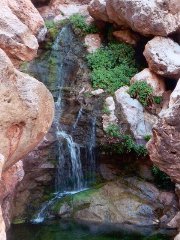 |
|
Waterfall and pool at Elves Chasm. |
This morning, there are a few small rapids, some splashing, but nothing serious; and after an hour or so Joe headed into shore at Elves Chasm at Mile 116 1/2. This is another side stream that falls down the rocks in pools and falls big and little, with verdant vegetation, and quite pretty, a green break in the continual earth tones and browns of the canyon. Along with the others, I scrambled up the stream partway to the big waterfall, but when the climbing got too steep I called it good enough, and settled for getting some studies of the gardenlike profusion of small waterfalls tumbling down over rocks through green vegetation and delicate flowers -- a beautiful spot, one of the nicer ones on the river.
Back on the river, I got to talking with Kathy -- to this point she'd shot about 300 frames of film, and 800 digital, making me feel like a piker -- I've only shot about 325 frames total, but we both agree that we face an awesome editing job, although nothing like what Jason will be facing. We ran on through the canyon, passing through a number of rapids, although none terribly big.
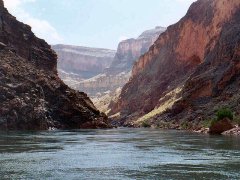 |
|
Middle Granite Gorge, on the morning of our fifth day out. |
By now we were in Middle Granite Gorge, and again the walls rise steeply above the Canyon, although much more open than the upper one. Here, there are frequently talus slopes halfway up the canyon, at least the parts that we can see. Unlike the upper river, now these slopes, and most surfaces sufficiently non-vertical to hold something resembling soil, are covered with the dull olive drab color of Sonoran desert vegetation, barrel cactus, sagebrush, prickley pear and the like, some whose names I don't know. We were coming to the end of the Utah agave country, an interesting plant we've seen frequently upriver, although rarely close by. At its base, it has a small ball-like pack of sharp leaves, but a single thick stalk extends high above, sometimes several feet. It's always interesting to see where these grow -- more than once I'd noticed them high on the rim of a cliff, the distinctive stalk silhouetted noticeably against the sky.
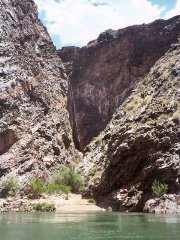 |
|
An interesting sidecanyon where we took a lunch stop to see if we could hike back to the waterfall in back, but it was too tough a climb. |
After a while, we passed an interesting looking side canyon that appeared to have a long waterfall behind it. Joe said he had never stopped there before, but why not? So we pulled in for lunch, and discovered that while it was pretty, there was no good way to get back to the waterfall without climbing equipment.
After an hour or so were on our way again, running through a beautiful, warm afternoon, the best weather we'd had on the trip. As always, Joe gave us a running explanation of what we were seeing; at one point, at Randy's Rock Rapid (Mile 126) he told us that if a rapid gets named after you if you're still alive it's usually something you'd really rather not remember. In this case, the boatman, Randy, several years ago, decided to take a nap while he let the swamper run the boat through this otherwise easy stretch. The swamper, relatively new to the river, decided to head down through this narrow but inviting passage behind this rock on river left, just to see what was there. Unfortunately, the passage was a lot narrower at the exit than at the entrance, and the swamper hit the passage hard enough that the raft was torn up and the frame got stuck in the rocks. Not a good afternoon.
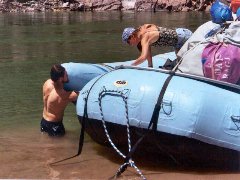 |
|
Joe and Parker fixing a busted frame strap they discovered at our lunch stop on the fifth day. |
Several miles below, we came to Specter Rapid, one of the two big ones we'd meet today, the other being Deubendorff, a few miles farther on. Only now did I pull on the rain suit, while Joe readied us for the rapids, which we could now see ahead, a white froth laying behind an obvious dropoff. "Gonna get wet in this one," Joe said, always a warning of a big rapid. "I'm going to need you down and in." Down means off the load, down on the sideboard, and in means that people can't ride the side tubes, which people do occasionally on the quiet stretches. Then, he gives the word that this rapid is really serious -- "Pull in the drag bags!" This means that there's a good chance of hitting something, or at least scraping it hard enough to make the MGD hunt in the evenings even worse.
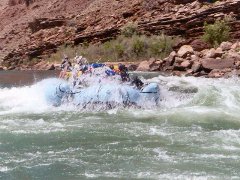 |
|
Josh's raft in Fossil Rapid. Gonna get wet in this one! |
We drift down on the rapid, Joe (or whoever is driving -- often it's Parker, and occasionally, one of the helpers) twists the raft this way and that to set up the entry. "Hang on," he yells. Then, the lip of the rapid is there, and we're lunging down the tongue at an rapid pace, then bouncing up over the first of the backrollers. The first backroller usually isn't bad, and the boat climbs up over it, but the length of the raft and the spacing of the backrollers means that sooner or later we're going to stick the nose into one. Rarely are they big enough to actually take water over the nose, but they're often big enough to send up a huge mound of spray. I wear a wide-brimmed hat, and after several days of practice, have learned to tip my head forward to take the worst of the spray heading for my head on my hat -- it keeps my glasses a little cleaner, although I still have to clean off the water droplet marks each evening.
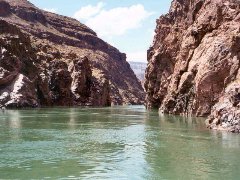 |
|
The narrows -- where the Canyon has it's narrowest point -- although it's quite deep and calm. |
Finally, sometimes only seconds, sometimes longer, we're out into the calm water below the rapid. We look back upstream, to see Josh and his raft plunge through behind us, and it always seems like his passengers get a drier ride than we have managed, although it's mostly for the sake of perspective, I guess. Once we were below Deubendorf (Mile 132) I peeled out of the rain gear -- it was awful warm out in the sun. We faced one more moderate rapid, Tapeats, but I figured if I got wet, I got wet -- it would feel good in the warmth of the sun. A couple miles later, we did run through Tapeats, and sure enough I did get a little wet, and sure enough, it felt good. We ran through a couple more small rapids, and about Mile 135 came to the narrowest point of the Canyon, where the river is compressed down to only about 75 yards -- but it's very deep and calm; Josh brought his raft alongside, and both motors were shut off as we drifted, held together by the strap ends that hold the side tubes on, being held by some of the passengers, while Joe talked a little more about the natural history of the place and where we were heading.
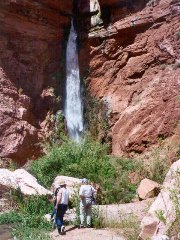 |
|
Deer Creek Falls -- one of the more spectacular ones. |
Where we were heading was Deer Creek, another of the famous places of the Canyon -- and one of the more frequented. It was hard to find a place to tie up on the small sand beach, and Joe had to scramble far up the rock to find a place to tie off the rope from the bow. There was a Hatch party of three rafts there, the gal with the Diamond River single boat trip was there, another party was tied up across the river at a campground, and while we were there a private trip, in oar boats and kayaks for a total of seven boats, joined us. I noticed that one of the kayaks was a Godzilla, which must be fun in the rapids but a real bear to paddle through all the flats.
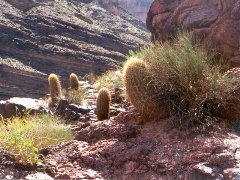 |
|
Barrel Cactus near Deer Creek Falls. |
The waterfall at Deer Creek is very spectacular, gushing forth from a narrow crack in a tall cliff in a stream that can't be more than a foot wide, plunging down in a shower of spray. Again, there's the verdant vegetation living in the moisture from the falls. Many of the party took a steep, tough hike to the top of the falls, where there's an interesting little pool, but I only went part way up the trail, mostly to get some pictures of some barrel cactus and prickly pear, and a tremendous view upriver. The trail was rough going, and was about all the rock scrambling I wanted, so I came back down, found a shady spot in behind a rock, where the afternoon breeze could get at me to cool off, and worked on my notebook for a bit.
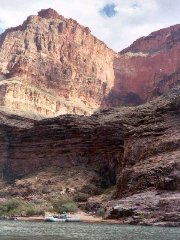 |
|
Another group pulling into a camp across the river from Deer Creek Falls. |
We hung around long enough for the hiking party to get back -- and found that yes, it was a tough hike -- then got back on the river. We didn't go far, less than a mile, to a spot on the other side of the river, where a huge vertical wall loomed high overhead, with a nice eddy and sand beach. Once again I hunted around for a good spot, found one, and discovered that was where the groover was going, so had to look elsewhere. The beach was a little sloped, and the only other possibilities seemed to be back out in a rock field, far from the beach, where here and there were patches of sand. Without much hope, I headed in that general direction, until I noticed a small, flat spot of sand, shielded from the irritating afternoon breeze coming up the canyon by a stand of tamarisks and a large, sloping rock. It seemed a touch on the small side, but was otherwise perfect, and so proved to be. The only thing it lacked was a view of the river -- it was on the back side of the rock, and the main view was that huge, vertical wall, but that wasn't all bad. Once again, home for the night. I dropped my PFD and day bag there, and went back down to help with the duffle line, unloading the boats of big bags and night bags and kitchen gear.
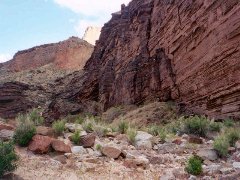 |
|
Rock field in back of the camp at Backeddy, where we spent the fifth night. |
By now, the getting set up in the evening was pretty well practiced. I started out by hauling all my gear up to my selected spot behind the rock and the tamarisks, setting it well out of the way, and opening the big bag to pull out the tarp ground cloth, which had been left on top. Since there was still some wind swirling around, I found a couple rocks in a dry wash only a few feet away, and used them to weight down the corners of the tarp. In this relatively sand free area, I dug into my night bag, pulled out my dry socks and camp shoes, and put them on, glad to be free of the wet feeling and wishing once again that I'd brought neoprene socks with me -- several times I'd had them in my hands while packing, but always there was the weight and volume problem, so gave them a pass. In fact, if I were doing this trip much earlier in the year, I would have gone ahead and brought the whole wet suit.
Feeling much better in dry socks and shoes, I put the wet ones on the rock, socks held down by shoes to keep from blowing away. We were already in the shade of the big wall behind camp, and somehow it seemed unlikely that they would be dry by morning, but drier would count and would soon get wet again, anyway. With that done, I could go ahead with setting up camp. I pulled out the pillow and sleeping bag and Paco Pad, leaving the first two to one side but still on the tarp while I let the Paco pad inflate itself. It took a few minutes, and I took the opportunity to smoke a cigarette and kick back. Along in there, I discovered the best part about this campsite -- if I sat on the pillow, I could lay back against the rock in a perfect lounge chair position, feeling very good. I sat like that for a while.
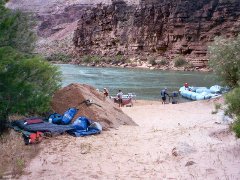 |
|
Home for the night -- my gear all laid out for nighttime at Backeddy. |
In the failing light, I got out a few things I'd need for the night -- flashlight, polypro underwear, and like that. One drybag was always the designated night stash, where things like a water bottle, the flashlight, cigarettes, lighter, and my glasses were stashed, and I made sure that things I'd need from the night bag in the morning were near the top. Finally, I spread out the sleeping bag, placed the air pillow in it, and with the exception of getting out of my clothes and into the polypro, was ready for the night.
Pretty soon, the crew called "Hordurves," which were muchies that would tide you over till dinner. I felt like I was eating enough on this trip, and rarely went down for them, although might on occasion if I wanted to go to the drag bag in the process. Not far away, the big propane heaters were boiling the water that would be needed for the dishwash lines, a roar that was always irritating, and it was especially so tonight, so I grabbed some munchies and headed for the drag bag. It was a little hard to get to them without getting my feet wet, so I had to climb up on one raft and over to the next one to get to them, but since I was already there decided it was a good place to sit, so sat there with three or four others, chewing the fat about this and that, until the crew called "Dinner."
Dinner tonight was chicken fajitas, sort of a make your own thing; I loaded up with chicken and refried beans, leaving the hot stuff go -- I didn't need the upset stomach. For once, I hit the seconds line; although I didn't need it, it tasted good, and there was almost always too much food for the whole group. There was plenty anyway; the food had been planned for 34 people and we only had 29, but it still would have been a feast for the full load.
By now, it was again getting dark, so I only sat around and talked for a bit before I headed up to my little campsite. It had been clear all day, but now it clouded up pretty good, and if it stayed that way pretty well assured us of a warm night. The cool breeze was dying out. In the gathering darkness, I took off my clothes, pulled on the polypro, then lay down on my back in the sleeping bag, glasses on, watching the stars come out. I soon realized I was having trouble staying awake, so turned onto my side, put the glasses away, and was asleep within minutes.




